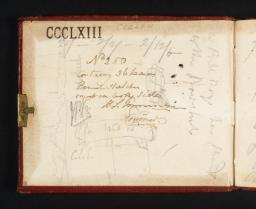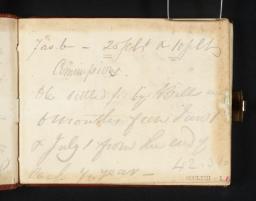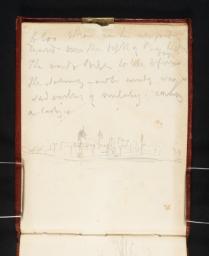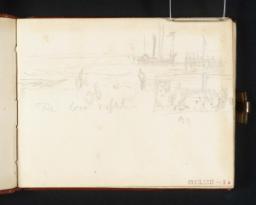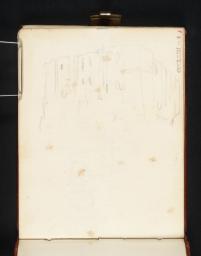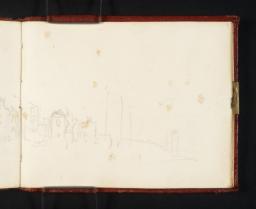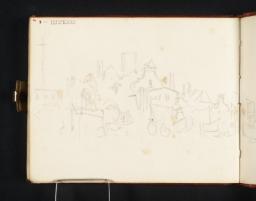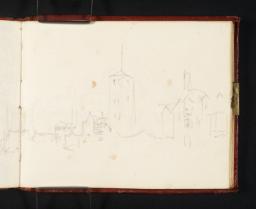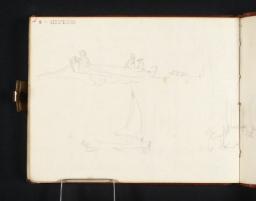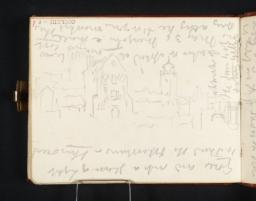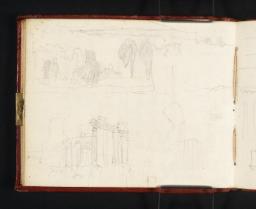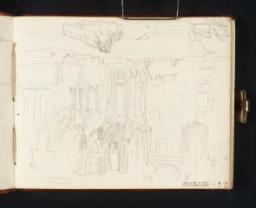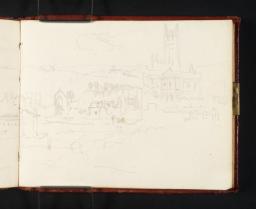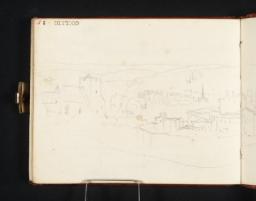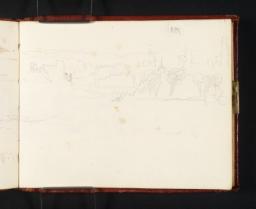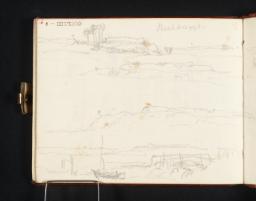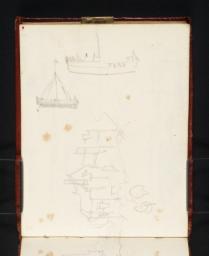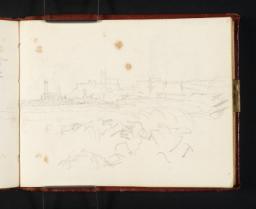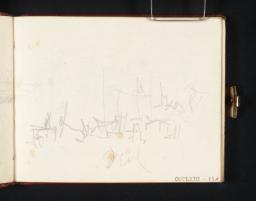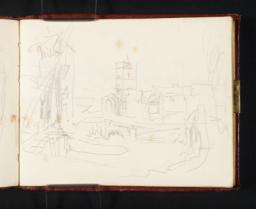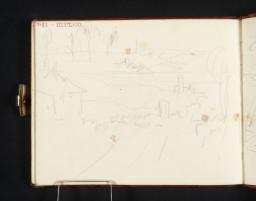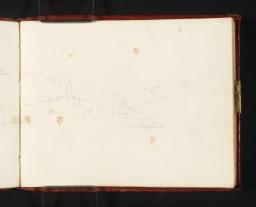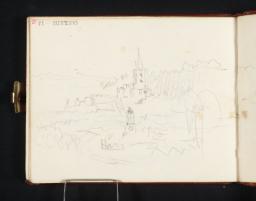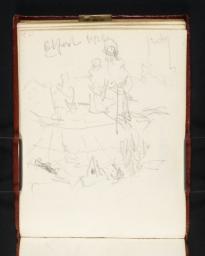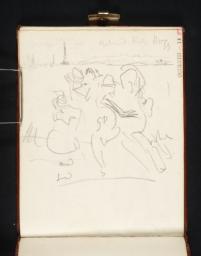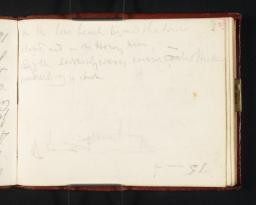Turner Bequest CCCLXIII 1–43a
Sketchbook bound in boards, covered in red-brown leather, with one brass clasp
44 leaves (two largely torn away) and paste-downs of white wove paper, the edges washed in yellow; page size 76 x 98 mm
Numbered 250 as part of the Turner Schedule in 1854 and endorsed by the Executors of the Turner Bequest, inside front cover (D41226)
Blind-stamped with Turner Bequest monogram on front cover, towards top left
Stamped in black ‘CCCLXIII’ top right
44 leaves (two largely torn away) and paste-downs of white wove paper, the edges washed in yellow; page size 76 x 98 mm
Numbered 250 as part of the Turner Schedule in 1854 and endorsed by the Executors of the Turner Bequest, inside front cover (D41226)
Blind-stamped with Turner Bequest monogram on front cover, towards top left
Stamped in black ‘CCCLXIII’ top right
Accepted by the nation as part of the Turner Bequest 1856
Exhibition history
References
Many of this sketchbook’s pages show the Kent subjects which give the book its established title, but its misleadingly late dating in Finberg’s 1909 Inventory has perhaps deflected subsequent commentators’ attention from the somewhat more diverse material scattered through it. The book has the distinction of being the last in Finberg’s attempt at a chronological arrangement of the Turner Bequest in the Inventory, where he placed it to about 1845–6.1
While less specialist Turnerians such as Jack Lindsay, who described it as the artist’s ‘last sketchbook’,2 have taken Finberg at his word, the book was first recognised as probably rather earlier by Andrew Wilton, discussing it in the context of Turner’s last visits to France in 1845, and considering that it ‘almost certainly belongs to and earlier period, perhaps the late 1820s’,3 a view with which David Blayney Brown has concurred.4 There is no internal evidence in terms of watermarks or inscribed dates, and Finberg seems to have placed it, for want of anywhere more obvious, after a sequence of other sketchbooks including Kent material in use in and around 1845: Near Folkestone (?), Hythe and Walmer, Ideas of Folkestone, Dieppe and Kent, and Folkestone (?) (all Tate; Turner Bequest CCCLIV, CCCLV, CCCLVI, CCCLXI, CCCLXII). In fact the last of these, now renamed Louis-Philippe at Portsmouth, is concerned with events at the Hampshire port in 1844; the small Channel sketchbook now at the Yale Center for British Art, New Haven, also belongs to that later period.
The present sketchbook is here redated to about 1830, for a variety of reasons. The most compelling is the presence of drawings now identified as relating to the large painting Caligula’s Palace and Bridge, exhibited at the Royal Academy in the spring of 1831 (Tate N00512),5 exploring themes reflecting the continuing repercussions of Turner’s extended visit to Italy in 1828–9. As discussed under folio 6 verso (D35768) there are clear studies of the overall composition and of architectural details within it.
1830 saw a renewed engagement with the poetry of Lord Byron (1788–1824),6 and it seems that while thinking of the Caligula’s Palace composition, Turner was also refamiliarising himself with the classical Byronic architectural and landscape subjects he had illustrated in the 1820s. A slight drawing of folio 6 verso (D35768) may be connected to a watercolour for the Landscape Illustrations engravings to complement the poet’s works (1832–3),7 while the main sketch on folio 44 verso (D35836; Turner Bequest CCCLXIII 43 a) can be related directly to another. Three of Turner’s vignette watercolours for the project are in the Tate Collection (N05238, N05242, N05243) and are addressed elsewhere in the present catalogue; see also Tate T07561.
In turn, this pictorial engagement with Byron may have revived Turner’s own poetic muse. Although he continued to include brief extracts from his ‘M.S. Fallacies of Hope’ as tags to his Royal Academy exhibits (including Caligula’s Palace), the very extensive drafts of poetry he composed in the late 1800s and early 1810s had largely tailed off in subsequent years;8 there are several pages in the present book on themes of lovers on lonely shores (see folios 15 verso, 16 verso, 17 recto, 29 verso, 30 recto, 30 verso, 31 recto, 32 recto; D35786, D35788, D35809–D35812, D35814, D41227; Turner Bequest CCCLXIII 15a, 16a, 17a, 28a, 29, 29a, 30, 31), with hints here and there of an episode he had explored occasionally over many years (see the Calais Pier sketchbook; Tate D04959; Turner Bequest LXXXI 57) culminating in the major painting of The Parting of Hero and Leander – from the Greek of Musaeus, exhibited at the Royal Academy in 1837 (Turner Bequest, National Gallery, London),9 accompanied by Turner’s own lines in the catalogue, concluding:
David Blayney Brown has suggested that Turner’s proximity to the English Channel, evident in the topographical views here while thinking afresh of Byron, may have evoked the Hellespont11 (the modern Dardanelles strait in Turkey) in his associative mind; the mythical Leander drowned there, but Byron famously succeeded in swimming it in May 1810 after touring Greece.12
The previous late dating of the book led to biographical speculation as to Turner’s activities and perceived infirmity towards the end of his life, as noted in entries for specific pages, and the effectively illegible scrawl and cosmic pessimism of some of the inscriptions has been seen as evidence of this, although this aspect of the artist’s world view was hardly new, and is comparable to that shown in the extensive and similarly near-illegible ‘Evening Star’ verses in the Worcester and Shrewsbury sketchbook, possibly written within a year or two of those here (see in particular the entry for Tate D22279; Turner Bequest CCXXXIX 70).
Most of the identified topographical views are around the eastern end of Kent. They do not appear to represent a programmatic tour, and apart from the familiar cathedral city of Canterbury (see under folio 3 recto; D35761) ten miles or so inland to the west, and Sturry, just to its north-east (see under folio 10 recto; D35775), they range up and down the Channel coast of the north-east tip of the county, from Margate near the North Foreland in the Isle of Thanet (see under folio 10 verso; D35776) a few miles south to Deal (see under folio 4 recto; D35763). There are numerous studies in and around medieval Sandwich (see under folio 6 recto; D35767), of the Roman ruins at nearby Richborough (giving further cause for reflection on the ancient past; see under folio 7 recto; D35769) and of the coast around Pegwell Bay (see under 6 verso; D35768). Folio 21 recto (D35795; Turner Bequest CCCLXIII 20) may show Walmer Castle, near Deal.
These latter subjects could all have been taken in over the course of a day or two’s leisurely wandering. Margate was probably his base, as he renewed his childhood connection with the town around this time, as set out in detail in the Introduction to the Marine Dabblers sketchbook (Tate; Turner Bequest CCXLI) in the present section, and Turner became a regular guest at the lodging house of Mrs Booth, his companion in later years. There may be views made at Greenwich, as Turner passed up and down the Thames between London and Margate, on folios 43 verso and 44 recto (D35834–D35835; Turner Bequest CCCLXIII 42a, 43); see also folio 18 verso (D35790; Turner Bequest CCCLXIII 17 a).
Landscapes with buildings including a church spire and a cupola among woods and hills on folios 12 verso, 13 recto and 14 recto (D35780, D35781, D35783), as well as 18 recto, 22 verso–23 recto, 37 verso–38 recto and 38 verso–39 recto (D35789, D35796, D35798, D35821, D35823–D35825; Turner Bequest CCCLXIII 17, 21–22, 36–37, 37a–38), currently remain unidentified, but many appear interrelated. They may be Kent subjects, or possibly interpolations from one of Turner’s tours further afield around England.
Scattered through the book are slight coastal studies, typical quick sketches of shipping, figures, the sun and clouds, and occasional pages of writing. There are financial notes on folio 1 recto (D35758), the names of stationers on folio 5 verso (D35766), hurried observations on a sunset on folio 6 recto (D35767), an unidentified ground plan on folio 13 verso (D35782), specifications for a building project on folio 16 recto (D35787), and observations concerning spring flowers on folio 42 recto (D35831; Turner Bequest CCCLXIII 41).
Folio 43 recto includes a figure study probably made at the Royal Academy’s Life Class (D35833; Turner Bequest CCCLXIII 42), a reminder of the importance of Turner’s continued involvement with the life of that institution. A last clue to the 1830 dating proposed here is the thumbnail sketch of geese hissing at pigs, which Turner noted as an allegory of the parties in the debate leading to the Great Reform Act of 1832; see under folio 44 recto (D35835; CCCLXIII 43). Despite the richness and variety of its content, Finberg recorded John Ruskin’s dismissive endorsement on a wrapper: ‘250. Valueless.’13
Lindsay 1966a, p.142, and 1966b, p.62; see also C[harles] Lewis Hind, Turner’s Golden Visions, London and Edinburgh 1910, p.221, Yardley 1984, p.55 note 2, and Bailey 1997, pp.388–9.
Martin Butlin and Evelyn Joll, The Paintings of J.M.W. Turner, revised ed., New Haven and London 1984, pp.189–90 no.337, pl.339 (colour).
See David Blayney Brown, Turner and Byron, exhibition catalogue, Tate Gallery, London 1992, and Jan Piggott and Martin Butlin, ‘Byron, Lord (1788–1824) in Evelyn Joll, Butlin and Luke Herrmann (eds.), The Oxford Companion to J.M.W. Turner, Oxford 2001, pp.35–6; the author is very grateful for the opportunity of discussing his ideas on the sketchbook’s likely Byron connections informally with David Blayney Brown, 17 February 2016.
Among Andrew Wilton, J.M.W. Turner: His Life and Work, Fribourg 1979, pp.444–7 nos.1210–1235, many reproduced; see also Jan Piggott and Martin Butlin, ‘Byron, Lord (1788–1824)’ in Joll, Butlin and Herrmann 2001, pp.35–6; and David Blayney Brown, Turner and Byron, exhibition catalogue, Tate Gallery, London 1992. Particularly pp.99–106.
See Andrew Wilton and Rosalind Mallord Turner, Painting and Poetry: Turner’s ‘Verse Book’ and his Work of 1804–1812, exhibition catalogue, Tate Gallery, London 1990, including transcriptions, pp.149–81, although the lines in the present sketchbook are not addressed.
Martin Butlin and Evelyn Joll, The Paintings of J.M.W. Turner, revised ed., New Haven and London 1984, pp.221–2 no.370, pl.374 (colour).
Conversation with the author, 17 February 2016; see also Lindsay 1966a, p.197, Brown 1987, p.18, and Gage 1987, p.181.
See Jerome McGann, ‘Byron, George Gordon Noel, sixth Baron Byron (1788–1824)’, Oxford Dictionary of National Biography, accessed 18 February 2016, http://www.oxforddnb.com/view/article/4279 .
Technical notes
How to cite
Matthew Imms, ‘Kent sketchbook c.1830’, sketchbook, September 2016, in David Blayney Brown (ed.), J.M.W. Turner: Sketchbooks, Drawings and Watercolours, Tate Research Publication, December 2016, https://www

